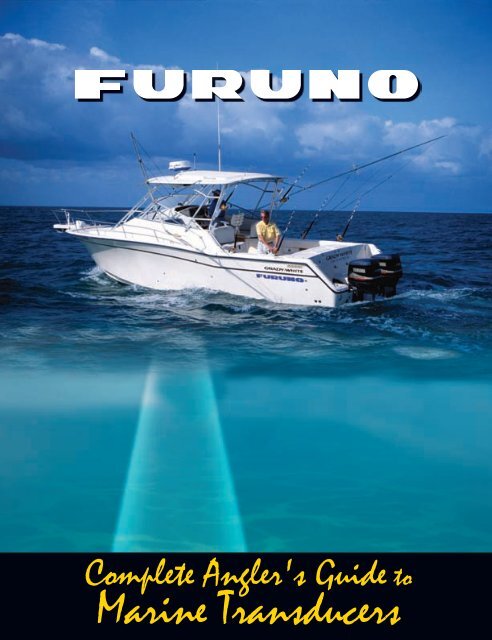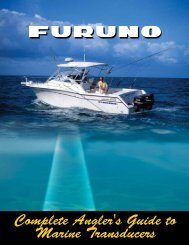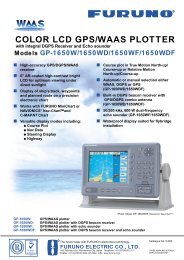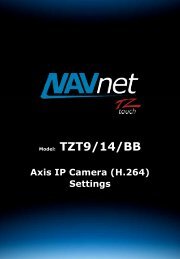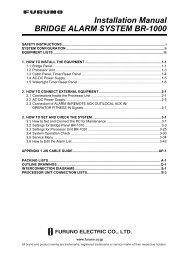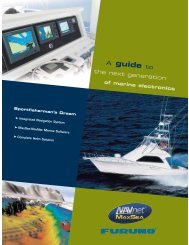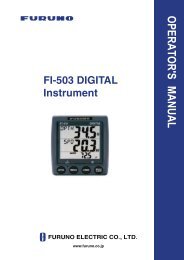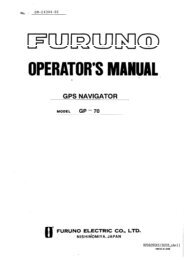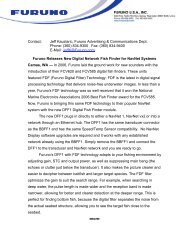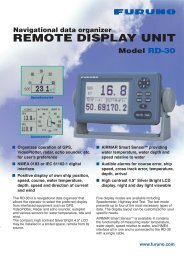Complete Anglers Guide to Transducers - Radar Marine Electronics
Complete Anglers Guide to Transducers - Radar Marine Electronics
Complete Anglers Guide to Transducers - Radar Marine Electronics
Create successful ePaper yourself
Turn your PDF publications into a flip-book with our unique Google optimized e-Paper software.
<strong>Complete</strong> Angler's <strong>Guide</strong> <strong>to</strong><br />
<strong>Marine</strong> <strong>Transducers</strong>
Table of Contents<br />
1-3) Theory of Operation<br />
4-5) Mounting Options & Installation tips<br />
6-7) Getting the most out of your Fish Finder<br />
8-10) Transducer Listings<br />
11) Multisensors, Speed and Temperature sensors<br />
12) Smart Sensors<br />
13) FAQ's<br />
14-15) Bot<strong>to</strong>m Coverage Table<br />
16) Defi nitions<br />
17) Additional Resources<br />
Pro anglers on the SKA and FLW circuits utilize the<br />
50/200 kHz frequencies <strong>to</strong> fi nd their winning catch.<br />
Furuno off ers a wide range of matched, high performance<br />
transducers for our depth sounders. There are<br />
transducers available for virtually every type and size<br />
of boat. There are also sensors you can install that will<br />
accurately read your boat speed and the surface water<br />
temperature. Because there are a number of variables in<br />
transducer types that can dramatically aff ect your fi sh<br />
fi nder's performance, understanding these variables is<br />
the key <strong>to</strong> selecting the right transducer. This book will<br />
help you learn about what makes a transducer ‘tick.’
How it works<br />
There are a wide variety of transducer options<br />
available for Furuno fi sh fi nders, but all of them<br />
operate on the same principle. At it’s most basic<br />
defi nition, a transducer is a device that takes energy<br />
from one source, converts that energy in<strong>to</strong><br />
some other form and then delivers that energy<br />
<strong>to</strong> a target, such as a PA system converting sound<br />
from a microphone in<strong>to</strong> electrical signals and<br />
then delivering that energy <strong>to</strong> the speakers. In<br />
the case of marine transducers, imagine that<br />
the same device can act as both the microphone<br />
and the speaker. Electricity from the fi sh fi nder<br />
is applied <strong>to</strong> the transducer, which sends out an<br />
acoustic signal - sound waves - in<strong>to</strong> the water<br />
column. The transducer receives the refl ected<br />
echoes from objects that these sound waves encounter<br />
and they are sent as an electrical signal<br />
<strong>to</strong> your fi sh fi nder. It is the fi sh fi nder's job <strong>to</strong><br />
process this signal in<strong>to</strong> a picture of the underwater<br />
world on your screen.<br />
The Essence of a Transducer<br />
The physical device inside a transducer that<br />
creates the sound wave is a piezoceramic disc<br />
called the element. The element, when voltage<br />
is applied, vibrates - it dis<strong>to</strong>rts and reforms its<br />
shape in very rapid succession. This vibration occurs<br />
at a specifi c frequency and creates compression<br />
waves, or acoustic energy - sound waves.<br />
These waves travel outward from the element<br />
in a vaguely cone-shaped pattern and encounter<br />
targets along the way.<br />
As this acoustic energy encounters targets such<br />
as fi sh or bot<strong>to</strong>m structure, some of the beam<br />
will be attenuated (absorbed by the target), some<br />
will be refl ected back at the transducer as an<br />
echo and some will be scattered. As the refl ected<br />
echoes strike the transducer they cause a minuscule<br />
dis<strong>to</strong>rtion in the shape of the crystal. This<br />
dis<strong>to</strong>rtion of the crystal creates a small fl uctuation<br />
of voltage, which can be detected and<br />
processed by the fi sh fi nder. The end result is an<br />
image on your display.<br />
By measuring the time from when the sound wave<br />
is generated <strong>to</strong> when the return echo is received,<br />
we can learn the depth at which a target is encountered.<br />
The strength of the refl ected echo can tell us<br />
about the size and density of the target.<br />
Some transducers are referred <strong>to</strong> as single-element<br />
transducers. This means that they contain a<br />
single piezoceramic disc that vibrates alternately<br />
at 50kHz and 200kHz, utilizing both operating frequencies.<br />
Furuno off ers a wide range of single-element<br />
transducers that are very popular and carry a<br />
low price tag.<br />
When greater performance is desired or required,<br />
multiple element transducers are available that<br />
can signifi cantly enhance the performance and<br />
sensitivity of your fi sh fi nder. A multiple-element<br />
transducer is one in which separate elements<br />
vibrate individually at their respective frequencies.<br />
Some high-end models utilize seven, nine or even<br />
fi fteen 50kHz elements along with a large-diameter<br />
200kHz element. The dedicated 200kHz element<br />
off ers enhanced sensitivity in shallow water, while<br />
the greater surface area of the 50kHz array will<br />
receive echoes from deeper water with much more<br />
clarity and detail.<br />
Many transducers are available with multiple elements<br />
for the 50kHz function and a single, large diameter<br />
200kHz element, delivering enhanced performance.<br />
* Shown with High Performance Fairing Block<br />
1
2<br />
Frequency and Beamwidth<br />
Frequency demystifi ed<br />
Frequency refers <strong>to</strong> the number of sound waves<br />
that radiate from a transducer each second. Sound<br />
waves are made up of high pressure and lowpressure<br />
pulses traveling through a given medium.<br />
The wavelength of sound is defi ned as the distance<br />
between two successive highpressure<br />
pulses or two successive<br />
low-pressure pulses. For<br />
example, when an electrical pulse<br />
is applied <strong>to</strong> a 200kHz transducer<br />
the element vibrates at a<br />
frequency of 200,000 cycles per<br />
second – that is, 200,000 individual<br />
sound waves are transmitted<br />
from the element each second.<br />
Short-wavelength, high frequency<br />
transducers produce sharp, crisp<br />
images on the fi sh fi nder display.<br />
Why use two frequencies?<br />
For recreational and sportfi shing<br />
applications, the 50/200kHz<br />
pairing of frequencies off ers an<br />
ideal balance of both shallow- and<br />
deep-water performance. The<br />
200kHz frequency produces<br />
sharp, crisp images in shallow<br />
water while 50kHz allows you <strong>to</strong><br />
“see” much deeper.<br />
Some frequency pairings are more<br />
suited <strong>to</strong> an individual application<br />
than others, and for this reason Furuno has always<br />
off ered the commercial and serious sport fi sherman<br />
a choice when it comes <strong>to</strong> selecting frequency pairs<br />
for a commercial fi sh fi nder. These include 28, 38,<br />
50, 88, 107 and 200kHz.<br />
Beamwidth<br />
The beamwidth of a transducer is a numeric value<br />
that describes the eff ective angle of the sound wave.<br />
This value is defi ned as the <strong>to</strong>tal angle between the<br />
points at which the acoustic energy has been reduced<br />
<strong>to</strong> half its peak value, commonly referred <strong>to</strong><br />
as -3dB down points. This value is<br />
important because it determines<br />
the area in which your fi sh fi nder<br />
will be able <strong>to</strong> “see.”<br />
As the frequency increases the<br />
beamwidth will become more<br />
narrow, similar <strong>to</strong> focusing the<br />
beam of a fl ashlight. As you adjust<br />
the lens, the beam of light focuses<br />
and covers a smaller area, delivering<br />
more energy on-target. This<br />
is more a function of the design<br />
of the transducer rather than an<br />
inherent property of frequency.<br />
Remember that the lower frequency<br />
wavelengths “see” deeper<br />
in the water column than higher<br />
frequency wavelengths, and so<br />
a boost in power is not always<br />
necessary <strong>to</strong> detect fi sh in deeper<br />
This image demonstrates the diff erence in<br />
beamwidth of 50kHz and 200kHz. In this ex- water. The lower in frequency<br />
ample, the wider 50kHz beam will show that you go, the deeper the echo<br />
returns for fi sh that the narrow 200kHz beam sounder will see for the same<br />
would have missed.<br />
amount of power. You can also<br />
increase the fi sh fi nders detection<br />
range in all frequencies by using a narrower beam<br />
transducer. A narrow beam delivers more energy ontarget,<br />
resulting in stronger echoes, improved target<br />
resolution, and the ability <strong>to</strong> “see” in deeper water.
The image <strong>to</strong> the right illustrates a typical beam pattern. It is a graphic<br />
representation of the pattern the acoustic energy takes as it radiates<br />
from the transducer. The center cone represents the energy within<br />
the -3db down points, what is referred <strong>to</strong> as the Mainlobe, and is the<br />
focus of the transducers energy. In this image we can see that not all of<br />
the energy is concentrated within the Mainlobe. Some of the acoustic<br />
energy spills out <strong>to</strong> the sides in what are referred <strong>to</strong> as Sidelobes, areas<br />
outside of the main beam in which a small level of energy is radiated.<br />
Since this energy is capable of producing return echoes from objects it<br />
encounters, it is possible <strong>to</strong> receive weak returns from the Sidelobes in<br />
shallow water.<br />
Target Masking<br />
Target masking is a phenomenon where acoustic energy from the<br />
transducer encounters a ledge which is only partially within the beam.<br />
This produces an echo which is sent back <strong>to</strong> the transducer sooner<br />
than the echo returned by either the sea bot<strong>to</strong>m or fi sh targets. The<br />
result is that these fi sh targets will not be discernible on the fi sh fi nder<br />
screen. This phenomenon can occur with trenches as well as when<br />
traveling over sloping ground.<br />
It is also possible <strong>to</strong> pick up a second echo from the sea bed, which will<br />
show as an echo on the screen at a greater depth than that of the ledge.<br />
Interference<br />
When two or more echo sounders are operating in close proximity and<br />
at the same frequency, it is possible for each <strong>to</strong> receive false returns<br />
from the others transducer. In such cases the opera<strong>to</strong>r will see noise<br />
and clutter, false returns, multiple bot<strong>to</strong>ms or other video anomalies<br />
on the screen. This is most common in and around marinas or harbors<br />
where there may be multiple fi sh fi nders operating at the same<br />
frequencies. Furuno fi sh fi nders have interference rejection circuitry<br />
which should be used in such instances, but use it sparingly <strong>to</strong> avoid<br />
eliminating small targets. Many boaters have found that adding a<br />
Furuno Smart Sensor, operating at 235kHz, will ensure a reliable numeric<br />
value for depth when their 50/200kHz fi sh fi nder suff ers from<br />
interference.<br />
3
4<br />
Mounting Options<br />
Selecting the mounting location<br />
Although it falls outside the scope of this guide <strong>to</strong> describe all of the details of installation, there are some<br />
important points that are true for every transducer installation. Acoustic noise is always present, and<br />
these sound waves can interfere with your transducers operation. Ambient (background) noise from<br />
sources such as waves, fi sh and other vessels cannot be controlled. However, carefully selecting your<br />
transducers mounting location can minimize the eff ect of vessel-generated noise from the propeller(s)<br />
and shaft(s), other machinery, and other fi sh fi nders. The lower the noise level, the higher the gain setting<br />
you'll be able <strong>to</strong> use eff ectively on your fi sh fi nder.<br />
Always select a location where:<br />
• Water fl owing across the hull is smoothest with a minimum of turbulence and bubbles<br />
• The transducer will be continuously immersed in water (not applicable for In-Hull models)<br />
• There is a minimum of deadrise angle<br />
• The transducer beam will not be obstructed by the keel or propeller shaft(s)<br />
• There is adequate headroom inside the vessel for the height of the housing, tightening the nuts, and<br />
removing the valve assembly and insert<br />
As a rule, no transducer should be located near a water intake or discharge opening, directly aft of any<br />
lifting strakes, steps or other obstructions or irregularities in the hull , or behind eroding paint (an indication<br />
of turbulence). The fl ow of water across the transducer face must be as smooth as possible in order<br />
<strong>to</strong> get the best performance while cruising.<br />
Fairing blocks<br />
The purpose of a fairing block is threefold: <strong>to</strong> compensate for the<br />
deadrise of the hull, <strong>to</strong> reduce drag, and <strong>to</strong> create a smooth surface for<br />
water <strong>to</strong> fl ow cleanly and unaerated across the face of the transducer.<br />
When a fairing block is correctly installed, boat drag will be minimized<br />
and the fl ow of water over the transducer face will be free of bubbles<br />
and turbulence.<br />
A standard fairing is of a similar shape <strong>to</strong> its companion transducer.<br />
By contrast, a high-speed fairing projects a longer, more streamlined<br />
form. This elongated wedge shape cuts the water in<strong>to</strong> two streams<br />
which fl ow along its sides <strong>to</strong>wards the tapered end, where they will<br />
smoothly rejoin. The result of a well-installed fairing is excellent fi sh<br />
fi nder performance above 15 knots.<br />
After the fairing is cut, it must be shaped <strong>to</strong> the hull as precisely as possible<br />
with a rasp or power <strong>to</strong>ol. A tight fi t will allow water <strong>to</strong> fl ow more<br />
smoothly over the transducer. If the transducer is recessed more than<br />
0.5 mm (1/64th inch) inside the fairing, you should either shim the<br />
transducer or carefully fi le or sand the fairing until the two are fl ush.<br />
With<br />
fairing block<br />
Without<br />
fairing block
l<br />
Through Hull<br />
Through-hull transducers require that a hole is cut in the hull, so<br />
their installation is more involved than a relatively simple transom<br />
mount. They are also more difficult <strong>to</strong> access for periodic<br />
cleaning, which they may require more often than a typical transom<br />
mount transducer. Owners of trailerable boats with throughhull<br />
transducers must be careful not <strong>to</strong> damage it when launching<br />
or loading the boat.<br />
To keep the transducer facing squarely downward in<strong>to</strong> the water<br />
column, a fairing block must be used. The fairing block is installed<br />
parallel <strong>to</strong> the flow of water <strong>to</strong> ensure proper boat handling, and<br />
this will not necessarily be the same from hull <strong>to</strong> hull.<br />
A fair amount of skill is required <strong>to</strong> achieve a proper through-hull installation. If in doubt, don’t go<br />
it alone - consult your local Furuno dealer for assistance.<br />
Transom Mount<br />
Transom mounting is the simplest method of transducer installation and is<br />
most common among smaller boats. The transducer is installed on the transom,<br />
slightly below the waterline. The transducer face should be at a slight<br />
angle forward so as <strong>to</strong> reduce the effects of turbulence and aerated water.<br />
In-Hull or Shoot-Through<br />
A third option when mounting your transducer is referred <strong>to</strong> as<br />
an in- hull, or shoot-through installation. An in-hull transducer is<br />
mounted on the inside of the hull. The transducer signal ‘shoots<br />
through’ the fiberglass and so the hull does not require a hole<br />
cut in it, although certain hull types may need <strong>to</strong> be bored out<br />
<strong>to</strong> remove any flotation material. When properly installed the<br />
effects of turbulence and aerated water are minimized. Because<br />
the transducer face does not <strong>to</strong>uch water, there is no real maintenance<br />
involved with an in-hull transducer. These are compelling<br />
arguments for shoot-through installations.<br />
These benefits do not come without a price, and that price is performance. The signal will experience<br />
loss when shooting through the hull material. This means that the performance of your fish<br />
finder will suffer. Most modern in-hull transducers are designed <strong>to</strong> compensate for this loss.<br />
Boats with wood, aluminum or steel hulls will not be able <strong>to</strong> use in-hull transducers, as these materials<br />
act as a very effective barrier against the acoustic signal. Sound waves simply will not propagate<br />
through these materials. Only fiberglass boats, with no flotation core, can utilize an in-hull<br />
transducer. Fiberglass boats with foam or balsa cores or those with air pockets will need <strong>to</strong> be ‘dug<br />
out’ so that the face of the transducer <strong>to</strong>uches the fiberglass. This can make installing an in-hull<br />
transducer a tricky proposition.<br />
5
6<br />
Getting the most<br />
out of your Fish Finder<br />
Standard vs. High Performance<br />
When you purchased your fish finder you made an investment,<br />
and <strong>to</strong> get the most out of that investment you will<br />
need <strong>to</strong> match it with the right transducer. Once you've<br />
selected your mounting method (In Hull, Through Hull or<br />
Transom Mount), you will need <strong>to</strong> select the right transducer.<br />
The best transducer for your needs will depend on<br />
a number of variables but there are some constants that<br />
should be considered and we'll go over those now.<br />
Most standard transducers are designed for recreational<br />
fish finders and generally have a single element that resonates<br />
alternately at 50 and 200 kHz. Although these transducers<br />
are effective and inexpensive, greater performance<br />
can be had by matching your recreational fish finder with a<br />
high-performance transducer. These transducers are rated<br />
Above is an actual screen shot of a<br />
for a greater power output and contain an array of 50kHz el-<br />
600 watt Furuno sounder utilizing the<br />
ements along with one or more large-diameter 200kHz ele- 525ST-MSD, a standard 50/200kHz<br />
ments. An array of 50kHz elements allows for a very tight transducer.<br />
beam pattern, meaning there will be more energy on-target<br />
<strong>to</strong> produce return echoes. Also, the greater surface area<br />
of this array makes the transducer more sensitive <strong>to</strong> return echoes,<br />
enabling greater target resolution on the screen. The same is true of<br />
having one large, dedicated 200kHz element - its tighter beamwidth<br />
and greater sensitivity create a better performing transducer at all<br />
power outputs.<br />
For example, a typical recreational fish finder will output 600 watts of<br />
energy and is designed <strong>to</strong> function with a matching triducer rated at<br />
600 watts. Pairing this fish finder with a high-performance transducer<br />
rated at 1,000 watts will drastically improve the performance of your<br />
fish finder.<br />
Smart Sensors connect directly <strong>to</strong> a variety of Furuno<br />
equipment, enabling you <strong>to</strong> upgrade your transducer<br />
without sacrificing speed and temperature information.<br />
Here is the same 600 watt sounder<br />
utilizing the 525T-HDD high performance<br />
transducer. The darker color<br />
illustrates the enhanced sensitivity<br />
available for most sounders.
Output wattage and performance<br />
Higher output power equates <strong>to</strong> greater depth range, as well as stronger returns on your fish finder<br />
screen. The actual depths you can reach with your fish finder will vary depending on a number of<br />
fac<strong>to</strong>rs including salinity, temperature and frequency as well as the quality of the transducer. The<br />
following maximum depths are general guidelines:<br />
100W = 400' Max Depth<br />
200W = 500' Max Depth<br />
300W = 600' Max Depth<br />
600W = 800'- 1200' Max Depth<br />
1KW = 1800' - 2500' Max Depth<br />
2KW = 2500' - 4000' Max Depth<br />
As we can see in the image at right, your fish finder can benefit from<br />
being matched <strong>to</strong> a transducer rated for a higher output wattage,<br />
but remember that the output wattage must always be less than<br />
or equal <strong>to</strong> the wattage of the transducer. If the echosounder has<br />
more output wattage than the transducer is capable of handling, the<br />
transducer will be damaged.<br />
Notice the difference in returns between<br />
the 600 watt output (left, with 525ST-<br />
MSD) and 1,000 watt output (right, with<br />
525T-HDD) from the GP7000F fish finder.<br />
When <strong>to</strong> use a matching box<br />
Most recreational fish finders have a single connection for your transducer. Because a standard<br />
transducer contains one vibrating element that alternates transmission frequency across a single<br />
line, only one line is required <strong>to</strong> send the electrical signal from the fish finder <strong>to</strong> the transducer and<br />
back. Multiple-element transducers always have separate signals for each frequency, and so some<br />
high-performance transducers come with a device called a diplexer installed inside the housing.<br />
A diplexer takes the electrical signal from the fish finder and distributes it <strong>to</strong> the individual<br />
50/200kHz arrays. It then combines the returning 50/200kHz signals so that they can be transmitted<br />
<strong>to</strong>gether across a single line. The result is a high-performance transducer that is able <strong>to</strong><br />
connect directly <strong>to</strong> a recreational fish finder, and one that will outperform a standard transducer<br />
matched <strong>to</strong> an identical fish finder.<br />
Not all high-performance transducers contain an internal<br />
diplexer. Matching a high-performance transducer and a<br />
recreational fish finder will sometimes require a diplexerlike<br />
device called a matching box. This is a simple device that<br />
separates and recombines the electrical signal. The result is<br />
a lower-wattage recreational fish finder capable of operating<br />
with the sensitivity and resolution of a more powerful commercial<br />
machine.<br />
The<br />
MB1100 Matching Box<br />
allows for the use of high<br />
performance transducers<br />
with your recreational<br />
Furuno fish finder.<br />
Broadband Technology<br />
“Broadband” is a term used <strong>to</strong> describe a method for increasing the available bandwidth (range of<br />
frequency) of a transducer element without lessening performance. Increased bandwidth allows<br />
for the faster rise and fall times of the acoustic pulse, the by product of which is referred <strong>to</strong> as ring.<br />
This decreased ringing presents a much crisper image on the fish finder screen, allowing for better<br />
discrimination of individual bait fish as well as an increase in the ability of the fish finder <strong>to</strong> differentiate<br />
between the sea floor and fish suspended very near <strong>to</strong> the bot<strong>to</strong>m. Broadband technology is<br />
available in select transducers.<br />
7
8<br />
<strong>Transducers</strong> - 50/200kHz<br />
Transducer<br />
Part number<br />
Power<br />
Rating<br />
Beam<br />
Angle<br />
Housing<br />
Type<br />
Plug<br />
Type<br />
Mount<br />
Type<br />
Cable<br />
Length<br />
Temp Fairing Block Compatible Models<br />
520-5MSD 600W 46/10 Bronze 10 Pin TH 10 M NO DFF1, LS4100, LS6100, FCV620,<br />
FCV585, GP7000F/NT<br />
520-5PSD 600W 46/10 Plastic 10 Pin TH 10 M NO DFF1, LS4100, LS6100, FCV620,<br />
FCV585, GP7000F/NT<br />
525-5PWD 600W 46/10 Plastic 10 Pin TM 10 M NO DFF1, LS4100, LS6100, FCV620,<br />
FCV585, GP7000F/NT<br />
525T-PWD 600W 40/10 Plastic 10 Pin TM 10 M YES DFF1, LS4100, LS6100, FCV620,<br />
FCV585, GP7000F/NT<br />
525T-PPD 600W 45/11 Plastic<br />
Puck<br />
10 Pin TM 15F YES DFF1, LS4100, LS6100, FCV620,<br />
FCV585, GP7000F/NT<br />
520-BLD 600W 45/12 Bronze 10 Pin TH-LP 10 M NO DFF1, LS4100, LS6100, FCV620,<br />
FCV585, GP7000F/NT<br />
520-IHD† 600W 45/11 Plastic 10 Pin IH 10 M NO DFF1, LS4100, LS6100, FCV620,<br />
FCV585, GP7000F/NT<br />
520-PLD 600W 45/12 Plastic 10 Pin TH-LP 10 M NO DFF1, LS4100, LS6100, FCV620,<br />
FCV585, GP7000F/NT<br />
525TID-BHD 1KW 50 = 3x5<br />
200 = 15x21<br />
Bronze 10 Pin TH 10 M YES AIR-033-523** DFF1, LS4100, LS6100, FCV620,<br />
FCV585, GP7000F/NT<br />
525T-BSD 600W 45/12 Bronze 10 Pin TH 10 M YES AIR-033-351<br />
AIR-033-352**<br />
525T-LTD/12 or<br />
525T-LTD/20<br />
526TID-LTD/12 or<br />
526TID-LTD/20<br />
555-SLTD/12 or<br />
555-SLTD/20<br />
556TID-LTD/12 or<br />
556TID-LTD/20<br />
600W 45/12<br />
Tilted<br />
1KW 20/6<br />
Tilted<br />
600W 20/6<br />
Tilted<br />
1KW 20/6<br />
Tilted<br />
DFF1, LS4100, LS6100, FCV620,<br />
FCV585, GP7000F/NT<br />
Bronze 10 Pin TH-LP 10 M YES DFF1, LS4100, LS6100, FCV620,<br />
FCV585, GP7000F/NT<br />
Bronze 10 Pin TH-LP 10M YES DFF1, LS4100, LS6100, FCV620,<br />
FCV585, GP7000F/NT<br />
SS 10-Pin TH-LP 10M YES DFF1, LS4100, LS6100, FCV620,<br />
FCV585, GP7000F/NT<br />
SS 10-Pin TH-LP 10M YES DFF1, LS4100, LS6100, FCV620,<br />
FCV585, GP7000F/NT<br />
SS60-SLD 600W 45/12 SS 10 Pin TH-LP 10 M NO DFF1, LS4100, LS6100, FCV620,<br />
FCV585, GP7000F/NT<br />
CA50/200-12M * 1KW 28/8.5 Bronze NC TH 10 M NO DFF1, LS4100, LS6100, FCV620,<br />
FCV585, GP7000F/NT<br />
CA50/200-1T * 1KW 28/8.5 Rubber NC C, H, T 10 M NO DFF1, LS4100, LS6100, FCV620,<br />
FCV585, GP7000F/NT<br />
526TID-HDD<br />
**, ***<br />
526TID-HDN<br />
*, **, ***<br />
1KW 19/6 Bronze 10 Pin TH 10 M YES AIR-033-391** DFF1, LS4100, LS6100, FCV620,<br />
FCV585, GP7000F/NT<br />
1KW 19/6 Bronze NC TH 10 M YES AIR-033-391** DFF3, FCV295, FCV1150, FCV1200<br />
and BB Models<br />
525TID-TMD 1KW 19/6 Urethane 10 Pin TM 10 M YES DFF1, LS4100, LS6100, FCV620,<br />
FCV585, GP7000F/NT<br />
527ID-IHD *** 1KW 19/6 In Hull 10 Pin IH 10 M NO DFF1, LS4100, LS6100, FCV620,<br />
FCV585, GP7000F/NT<br />
527ID-IHN*, *** 1KW 19/6 In Hull NC IH 10 M NO DFF3, FCV295, FCV1150, FCV1200<br />
and BB Models<br />
556TID-HDD<br />
**, ***<br />
1KW 19/6 SS/Urethane<br />
Broadband<br />
10 Pin TH 10 M YES (TBA,<br />
included)<br />
556TID-HDN*, ** 1KW 19/6 SS NC TH 10 M YES (TBA,<br />
included)<br />
556TID-HWD** 1KW 25 SS 10 Pin TH 10 M YES (TBA,<br />
Included)<br />
556TID-HWN *, ** 1KW 25 SS NC TH 10 M YES (TBA<br />
Included)<br />
CA50/200TID-R99 2KW 50 = 9x17<br />
200 = 6<br />
CA50/200ID-R199 2KW 50 = 9x17<br />
200 = 6<br />
DFF1, LS4100, LS6100, FCV620,<br />
FCV585, GP7000F/NT<br />
DFF3, FCV295, FCV1150, FCV1200<br />
and BB Models<br />
DFF1, LS4100, LS6100, FCV620,<br />
FCV585, GP7000F/NT<br />
DFF1, LS4100, LS6100, FCV620,<br />
FCV585, GP7000F/NT<br />
Epoxy NC TH 10 M Yes DFF3, FCV295, FCV1150, FCV1200<br />
and BB Models<br />
Epoxy NC IH 10 M NO DFF3, FCV295, FCV1150, FCV1200<br />
and BB Models<br />
* Must connect <strong>to</strong> MB1100 <strong>to</strong> use with: DFF1, LS4100, LS6100, FCV620, FCV585, GP7000F/NT ** High Performance Fairing Block included;<br />
*** Broadband Transducer (200 kHz function only); † Includes connec<strong>to</strong>r for optional Speed/Temp<br />
Legend: W=Watts, KW = Kilowatts, SS = Stainless Steel, NC = No Connec<strong>to</strong>r, TH - Thru Hull, TM = Transom Mount, IH = In Hull, LP = Low Profi le,<br />
Some of these transducers are available with 8-Pin connec<strong>to</strong>rs for use with older Furuno CRT model sounders. See your Furuno dealer for availability.
<strong>Transducers</strong> - 50kHz or 200kHz<br />
Transducer<br />
Part number<br />
Power<br />
Rating<br />
Beam<br />
Angle<br />
Housing<br />
Type<br />
Plug<br />
Type<br />
Mount<br />
Type<br />
Cable<br />
Length<br />
Compatible Models<br />
Single Frequency, High Power 200 kHz<br />
CA200B-5 1KW 8.5 Bronze NC TH 50 Feet DFF3, FCV295, FCV1150, FCV1200 and BB Models<br />
CA200B-5S 1KW 8.5 Rubber NC C, H, T 50 Feet DFF3, FCV295, FCV1150, FCV1200 and BB Models<br />
CA200B-8B 2KW 5.5 Rubber NC C, H, T 50 Feet DFF3, FCV295, FCV1150, FCV1200 and BB Models<br />
CA200B-82M 2KW 5.5 Bronze NC TH 50 Feet DFF3, FCV295, FCV1150, FCV1200 and BB Models<br />
CA200B-12H 2KW 16x16 Rubber NC T 50 Feet DFF3, FCV295, FCV1150, FCV1200 and BB Models<br />
Single Frequency, High Power 50 kHz<br />
CA50B-6B 1KW 28 Rubber NC C, H, T 50 Feet DFF3, FCV295, FCV1150, FCV1200 and BB Models<br />
CA50B-9B 1KW 12 X 28 Rubber NC C, H, T 50 Feet DFF3, FCV295, FCV1150, FCV1200 and BB Models<br />
CA50B-12 2KW 12 X 12 Rubber NC T 50 Feet DFF3, FCV295, FCV1150, FCV1200 and BB Models<br />
CA50BL-12 2KW 18.5 X 25 Rubber NC T 50 Feet DFF3, FCV295, FCV1150, FCV1200 and BB Models<br />
CA50F-24H 3KW 9 X 13 Rubber NC T 50 Feet DFF3, FCV295, FCV1150, FCV1200 and BB Models<br />
CA50BL-24H 3KW 13 X 19 Rubber NC T 50 Feet DFF3, FCV295, FCV1150, FCV1200 and BB Models<br />
Paired <strong>Transducers</strong> - 50kHz or 200kHz<br />
Because the beamwidths are the same for both 50kHz SS264W-50 and 200kHz SS264W-200, a split-screen fi shfi nder display will<br />
clearly show the same water column and bot<strong>to</strong>m coverage when these two wide-beam transducers are connected. The narrow-beam,<br />
broadband 200 kHz SS264N-200 transducer will give you excellent resolution and crisp image detail needed for bot<strong>to</strong>m fi shing. The<br />
low-profi le design of these transducers is perfect for fast, trailered, <strong>to</strong>urnament, sport-fi shing vessels that cannot install a thru-hull<br />
with a high-performance fairing. High-performance, wide-beam ceramic elements are tilted inside the housings, compensating for<br />
your boats deadrise.<br />
Transducer<br />
Part number<br />
Power<br />
Rating<br />
Beam<br />
Angle<br />
Housing<br />
Type<br />
Plug<br />
Type<br />
Mount<br />
Type<br />
Cable<br />
Length<br />
Temp Speed Compatible Models<br />
Pair consists of one Single Frequency, Narrow Beam 200 kHz + one Wide or Narrow Beam 50kHz transducer<br />
SS264w-50/12 600W/1kW 25 SS NC LP 10 M YES NO DFF1, LS4100, LS6100, FCV620, FCV585, GP7000F/NT<br />
SS264w-50/20 600W/1kW 25 SS NC LP 10 M YES NO DFF1, LS4100, LS6100, FCV620, FCV585, GP7000F/NT<br />
SS264w-200/12 600W/1kW 25 SS NC LP 10 M YES NO DFF1, LS4100, LS6100, FCV620, FCV585, GP7000F/NT<br />
SS264w-200/20 600W/1kW 25 SS NC LP 10 M YES NO DFF1, LS4100, LS6100, FCV620, FCV585, GP7000F/NT<br />
SS264N-200/12 600W/1kW 6 SS NC LP 10 M YES NO DFF1, LS4100, LS6100, FCV620, FCV585, GP7000F/NT<br />
SS264N-200/20 600W/1kW 6 SS NC LP 10 M YES NO DFF1, LS4100, LS6100, FCV620, FCV585, GP7000F/NT<br />
*Beam Angle varies with frequency<br />
SS264 Paired <strong>Transducers</strong><br />
R199 In-Hull<br />
9
10<br />
<strong>Transducers</strong> - Other frequencies<br />
Although the vast majority of fish finders operate at the 50/200kHz, there are many other frequencies available that are utilized<br />
almost exclusively in commercial applications. These include 15, 28, 33, 38, 40, 88 and 107kHz. The following is a list of Furuno<br />
transducers that operate within these frequencies.<br />
Commercial transducers such as these are generally mounted in tanks or sea chests that are cus<strong>to</strong>m-built in<strong>to</strong> the ships hull.<br />
Some transducers are designed exclusively for use with Net Sounders, while others are used by commercial fishermen or other<br />
high seas vessels that require the most reliable depth sounders available.<br />
Transducer<br />
Part number<br />
Frequency Power<br />
Rating<br />
Beam<br />
Angle<br />
Housing<br />
Type<br />
CV102 24 kHz 10kW 9 x 10 Rubber<br />
Coated<br />
CA28TID-S261<br />
(w/temp + HSFB)<br />
Plug<br />
Type<br />
Mount<br />
Type<br />
Cable<br />
Length<br />
NP Tank 30<br />
Meter<br />
28kHz 1kW 23 x 32 SS NP TH 10<br />
Meter<br />
CA28BL-6HR 28kHz 2kW 22 x 32 FRP NP Tank 15<br />
Meter<br />
CA28BL-12HR 28kHz 3kW 16 x<br />
21.5<br />
CA28F-18 28kHz 2kW 17 x 18 Rubber<br />
Coated<br />
CA28F-24H 28kHz 3kW 18 x 24 Rubber<br />
Coated<br />
CA28F-38M 28kHz 5kW 14 Rubber<br />
Coated<br />
CA28f-72 28kHz 10kW 12 x 16 Rubber<br />
Coated<br />
CA28F-8 28kHz 1kW 31 x 34 Rubber<br />
Coated<br />
CA33B-6 33kHz Net Sounder<br />
Use Only<br />
CA38BL-9HR 38kHz 2kW 20.5 x<br />
20.5<br />
CA38BL-15HR 38kHz 3kW 12.5 x<br />
21<br />
CA40B-6B 40kHz Net Sounder<br />
Use Only<br />
FRP NP Tank 15<br />
Meter<br />
Rubber<br />
Coated<br />
NP Tank 15<br />
Meter<br />
NP Tank 15<br />
Meter<br />
NP Tank 30<br />
Meter<br />
NP Tank 15<br />
Meter<br />
NP Tank 15<br />
Meter<br />
NP Tank 30<br />
Meter<br />
FRP NP Tank 15<br />
Meter<br />
FRP NP Tank 15<br />
Meter<br />
Rubber<br />
Coated<br />
CA88F-126H 88kHz 5kW 4 x 5 Rubber<br />
Coated<br />
CA88B-10 88kHz 2kW 8 Rubber<br />
Coated<br />
CA88B-8 88kHz 1kW 11 Rubber<br />
Coated<br />
CA100B-10R 107kHz 3kW 8 x 13 Rubber<br />
Coated<br />
NP Tank 30<br />
Meter<br />
NP Tank 15<br />
Meter<br />
NP Tank 15<br />
Meter<br />
NP Tank 15<br />
Meter<br />
NP Tank 10<br />
Meter<br />
Compatible Models<br />
FCV10<br />
DFF3, FCV295, FCV1150, FCV1200 and BB<br />
Models<br />
DFF3, FCV295, FCV1150, FCV1200 and BB<br />
Models<br />
DFF3, FCV295, FCV1150, FCV1200 and BB<br />
Models<br />
DFF3, FCV295, FCV1150, FCV1200 and BB<br />
Models<br />
DFF3, FCV295, FCV1150, FCV1200 and BB<br />
Models<br />
DFF3, FCV295, FCV1150, FCV1200 and BB<br />
Models<br />
DFF3, FCV295, FCV1150, FCV1200 and BB<br />
Models<br />
DFF3, FCV295, FCV1150, FCV1200 and BB<br />
Models<br />
Net Sounder Use Only<br />
DFF3, FCV295, FCV1150, FCV1200 and BB<br />
Models<br />
DFF1, LS4100, LS6100, FCV620, FCV585,<br />
GP7000F/NT<br />
Net Sounder Use Only<br />
DFF3, FCV295, FCV1150, FCV1200 and BB<br />
Models<br />
DFF3, FCV295, FCV1150, FCV1200 and BB<br />
Models<br />
DFF3, FCV295, FCV1150, FCV1200 and BB<br />
Models<br />
DFF3, FCV295, FCV1150, FCV1200 and BB<br />
Models
Multi Sensors - 50/200kHz<br />
Furuno offers a wide selection of multi sensors for use with our recreational fish finders. Multi sensors, also referred <strong>to</strong> as triducers,<br />
combine standard 50/200 kHz transducers with speed and temperature functions in<strong>to</strong> a single package. The benefit of having a multi<br />
sensor is ease of installation, since there is only one unit <strong>to</strong> be installed that provides depth, speed and temperature functions. Furuno<br />
offers a variety of multi sensors that are cost-effective and very efficient for most recreational applications.<br />
Transducer<br />
Part number<br />
Power<br />
Rating<br />
Beam<br />
Angle<br />
Housing<br />
Type<br />
Plug<br />
Type<br />
Mount<br />
Type<br />
Cable<br />
Length<br />
Dual Frequency 200 & 50 kHz Multi Sensors<br />
Speed & Temp Sensors<br />
Furuno speed and temperature sensors offer highly accurate data for your fish finder or digital temperature display. Unlike Smart<br />
Sensors, these sensors require a connection <strong>to</strong> specific equipment, either as an insert for a matching transducer or as a component<br />
of a dedicated system, such as the T-2000 Digital Temperature Display.<br />
Model Functions Housing Style<br />
ST-01PTB Speed and Temperature (+/ - 1 degree ) S63 Plastic Clip On (requires Transom Mount Bracket, part # AIR-020-058)<br />
ST-02MSB Speed and Temperature (+/ - 1 degree ) B17 Bronze Thru-Hull<br />
ST-02PSB Speed and Temperature (+/ - 1 degree ) P17 Plastic Thru-Hull<br />
CAT2000/TH Temperature (+/ - 1 degree ) Bronze Thru-Hull<br />
Temp Speed Fairing Block Compatible Models<br />
525STID-PWD 600W 45/11 Plastic 10 Pin TM 10 M YES YES na DFF1, LS4100, LS6100, FCV620,<br />
FCV585, GP7000F/NT<br />
525STID-MSD 600W 45/12 Bronze 10 Pin TH 10 M YES YES AIR-033-428<br />
AIR-033-476**<br />
(HSFB included)<br />
525STID-MSD7 600W 45/12 Bronze<br />
7" Stem<br />
Transducer<br />
Part number<br />
Power<br />
Rating<br />
Beam<br />
Angle<br />
Housing<br />
Type<br />
DFF1, LS4100, LS6100, FCV620,<br />
FCV585, GP7000F/NT<br />
10 Pin TH 10 M YES YES AIR-033-080** DFF1, LS4100, LS6100, FCV620,<br />
FCV585, GP7000F/NT<br />
Variable Frequency <strong>Transducers</strong><br />
The variable frequency of these transducers allows you <strong>to</strong> change the beamwidth and depth capabilities. If you are bot<strong>to</strong>m fishing in 200'<br />
of water, the narrow high-frequency beam will display extreme bot<strong>to</strong>m detail and fish holding tight <strong>to</strong> structure. If you are fishing in deep<br />
blue water, the wider, low-frequency beam will not only give deep-water bot<strong>to</strong>m detail, but more importantly show you more of what is<br />
around your vessel, including bait which may attract game fish. Because the bandwidth covers a continuous frequency spectrum, next<br />
generation fishfinders utilizing Furuno Free Synthesizer (FFS) technology can be made “tunable”, so you can “dial-in” the best frequency<br />
Plug<br />
Type<br />
Mount<br />
Type<br />
Cable<br />
Length<br />
Temp Speed Compatible Models<br />
Variable Frequency, High Power<br />
R209TIDN 2/3KW * Urethane NC TH 50 Feet YES NO DFF3, FCV295, FCV1150, FCV1200 and BB Models<br />
R299ID-IHN 2/3KW * Urethane NC IH 50 Feet NO NO DFF3, FCV295, FCV1150, FCV1200 and BB Models<br />
R309TIDN 2/3KW * Urethane NC TH 50 Feet YES NO DFF3, FCV295, FCV1150, FCV1200 and BB Models<br />
R399ID-IHN 2/3KW * Urethane NC IH 50 Feet NO NO DFF3, FCV295, FCV1150, FCV1200 and BB Models<br />
CA82B-35R 2KW * FRP NC T 50 Feet NO NO DFF3, FCV295, FCV1150, FCV1200 and BB Models<br />
*Beam Angle varies with frequency - higher frequency = narrower beam angle<br />
11
12<br />
Smart Sensors<br />
If you are looking for a solution <strong>to</strong> show you precision depth in water as shallow as 2 feet and<br />
temperature changes as minute as 2/100 ths of a degree, then the Furuno Smart Sensor is the answer.<br />
What is a Smart Sensor<br />
Furuno Smart Sensors are transducers specifically<br />
designed <strong>to</strong> give an accurate numerical value for depth<br />
instead of drawing an image on the screen.<br />
Smart Sensors are available in a variety<br />
of housing styles and can be transom<br />
or thru-hull mounted on the vessel.<br />
Processing of the return echoes is<br />
accomplished by circuitry within the<br />
transducer housing and then output as<br />
NMEA0183 or NMEA2000 information<br />
- electronic text that can be interpreted<br />
and displayed by a variety of Furuno electronics<br />
such as GPS, chart plotters, NavNet 3D,<br />
FI50 Series Instruments, or our popular RD30 NMEA data<br />
repeater. Molded, waterproof 7-pin or 10-pin connec<strong>to</strong>rs<br />
connect directly <strong>to</strong> these and many other Furuno products.<br />
NMEA0183<br />
Models<br />
Functions Housing Style<br />
235DT-PSE Depth and Temperature (+/ - 1 degree ) P17 Plastic Thru-Hull<br />
235DST-PSE Depth, Speed and Temperature (+/ - 1 degree ) P17 Plastic Thru-Hull<br />
235DT-MSE Depth and Temperature (+/ - 1 degree ) B17 Bronze Thru-Hull<br />
235DST-MSE Depth, Speed and Temperature (+/ - 1 degree ) B17 Bronze Thru-Hull<br />
235DHT-MSE Depth and Precision Temperature (+/- 0.02 degree) B17 Bronze Thru Hull<br />
235DHT-LMSE Depth and Precision Temperature (+/- 0.02 degree) B122 7" Bronze Thru Hull<br />
235DST-PWE Depth, Speed and Temperature (+/- 1 degree) P66 Plastic Transom Mount<br />
NMEA2000<br />
Models<br />
Functions Housing Style<br />
DST-800PSF Depth, Speed and Temperature (+/ - 1 degree ) P17 Plastic Thru-Hull<br />
DST-800PWF Depth, Speed and Temperature (+/ - 1 degree ) P17 Plastic Thru-Hull<br />
DT-800PSF Depth and Temperature (+/ - 1 degree ) P66 Plastic Transom Mount<br />
DST-800MSF Depth, Speed and Temperature (+/ - 1 degree ) B17 Bronze Thru-Hull<br />
DT-800MSF Depth and Temperature (+/ - 1 degree ) B17 Bronze Thru Hull<br />
235-MSLF Depth and Temperature (+/ - 1 degree ) B122 7" Bronze Thru Hull<br />
235-IHF Depth only P79 Plastic In Hull<br />
All Smart Sensors operate at 235 kHz, so they will never interfere<br />
with your fish finder's performance.<br />
B17 Bronze Thru-Hull<br />
P17 Plastic Thru-Hull<br />
B122 7" Bronze Thru-Hul
Transducer FAQ's<br />
We've gathered a short list of frequently asked questions about transducers and provided the answers in this section. If you<br />
have a question that is not answered in this book, you can visit us on the web at www.FurunoUSA.com and click on Support. You<br />
can browse through our comprehensive library of answers <strong>to</strong> questions, or search for your answer by model, <strong>to</strong>pic or keyword.<br />
If you can't fi nd the answer you're looking for, you can always send an Email directly from our web site <strong>to</strong> our technical support<br />
staff . A knowledgeable technician will respond with your answer, generally within 48 hours.<br />
Q: My transducer needs <strong>to</strong> be cleaned frequently. Is there any type of paint I can use <strong>to</strong> prevent<br />
barnacles, algae and marine growth from fouling it?<br />
A: There are several manufacturers of anti-fouling marine paint. These paints are available from marine<br />
supply s<strong>to</strong>res. Furuno recommends spray-on Transducer Paint from Pettit Paints .<br />
(www.PettitPaint.com)<br />
Q: What type of housing should I choose for my transducer?<br />
A: The type of housing you select depends on the hull where it will be installed:<br />
• A plastic housing is recommended for fi berglass or metal hulls only. Never install a plastic thruhull<br />
sensor in a wood hull, since swelling of the wood may overstress the plastic and cause a fracture.<br />
• A bronze housing is recommended for fi berglass or wood hulls only. Never install a bronze housing<br />
in a metal hull, because electrolytic corrosion will occur.<br />
• A stainless steel housing is recommended for metal hulls <strong>to</strong> prevent electrolytic corrosion.<br />
• Never install a metal housing in a vessel with a positive ground system.<br />
Q: Will a fairing aff ect the performance and <strong>to</strong>p-speed of my boat?<br />
A: The size of the transducer will have some aff ect on the <strong>to</strong>p-speed of the boat. However if you use a<br />
high-performance fairing, the loss will be minimal. Some people report a decrease of one or two knots.<br />
Generally, a 30 foot (10m) or longer boat will see almost no speed loss.<br />
Q: Can I cut my transducer cable?<br />
A: Yes, the transducer cable can be cut. However, if the transducer came with a connec<strong>to</strong>r do not<br />
cut it off . The molded on connec<strong>to</strong>r is waterproof. You need <strong>to</strong> cut and splice the cable away from<br />
the connec<strong>to</strong>r using Airmar's splash-proof Junction Box. The connections will not corrode and the<br />
strain relief grommets are water resistant and have excellent cable retention. Please note that cutting<br />
the cable or removing the connec<strong>to</strong>r, except when using Airmar's junction box, will void the sensor<br />
warranty. You can buy a junction box and splice kit from Gem <strong>Electronics</strong>.<br />
Gem <strong>Electronics</strong><br />
Phone: 843-394-3565 Fax: 843-394-3736.<br />
Q: Why does my depth sounder fail when I reach moderate speed?<br />
A: If a sounder works fi ne at slow speeds but gradually loses the bot<strong>to</strong>m as the vessels speed increases,<br />
it is an indication that aerated water is fl owing over the transducer. Rather than relocate a thru-hull<br />
transducer, try installing it with a high-performance fariring. High-performance fairings are designed<br />
<strong>to</strong> improve a sounder's performance at speeds above 17MPH (15kn). It is much longer than its<br />
companion transducer. The elongated streamlined shape cuts smoothly through the water, so there is<br />
less aerated water fl owing over the transducer's face.<br />
For more FAQ information, visit our web site at www.FurunoUSA.com/Support<br />
13
16<br />
Defi nitions<br />
Acoustic: Relating <strong>to</strong> sound and sound waves.<br />
Acoustic Property: The ability of a material <strong>to</strong> carry sound<br />
through it.<br />
Acoustic Window: That part of the transducer through which<br />
the ultrasonic vibrations from the piezoceramic assembly<br />
travel <strong>to</strong> water.<br />
Air Bladder: An organ in a fi sh which allows it <strong>to</strong> adjust <strong>to</strong><br />
changes in water pressure at diff erent depths.<br />
Amplitude: The degree of intensity (pressure) of a sound<br />
wave. If we could hear the sound wave, amplitude would be<br />
it's 'loudness.'<br />
Array: A series of elements in a transducer.<br />
Beamwidth: The diameter of a circle in which 50%-70% of the<br />
sound waves emitted by the transducer are concentrated.<br />
Cone Angle: The measurement of beamwidth in degrees.<br />
indicates how large an area is covered by a transducer's<br />
soundbeam.<br />
dB: Abbreviation for decibel, a unit for measuring the power<br />
of a sound wave.<br />
Echosounder: An instrument comprised of a display screen<br />
and electronic circuitry used <strong>to</strong> interpret information from<br />
the transducer and display it in a readable format.<br />
Frequency: The number of complete cycles or vibrations that<br />
occur within a specifi c time frame, typically one second. Usually<br />
measured in Hertz.<br />
Hertz: A measure of one cycle or complete vibration per<br />
second.<br />
In-Hull: The method of installing a transducer by attaching it<br />
<strong>to</strong> the inside of the hull.<br />
Multisensor: A combination of three sensing<br />
devices (depth, speed and temperature) in a<br />
single housing.<br />
Phased Array: A series of piezoceramic elements in a transducer,<br />
typically wired <strong>to</strong> allow them <strong>to</strong> fi re in time delayed sequence<br />
so the echosounder can electronically steer the array.<br />
Piezoceramic Element: A material made of crystals with positive<br />
and negative charges.<br />
Resolution: The sounders ability <strong>to</strong> show fi ne detail and <strong>to</strong><br />
discriminate between individual objects.<br />
Sidelobes: Portion of the acoustic image that lies outside of<br />
the main sound beam.<br />
Sonar: Derived from the words Sound Navigation and Ranging.<br />
An apparatus that uses refl ected sound waves <strong>to</strong> detect<br />
and locate objects underwater.<br />
Thru-Hull: A method for installing a transducer through a<br />
hole in the hull.<br />
Transducer: A device that changes electrical energy <strong>to</strong> acoustic<br />
energy and back again.<br />
Transom Mount: A method of installing a transducer on the<br />
back (transom) of the boat.<br />
Ultrasonic: Sound waves of high frequency (above 20,000<br />
Hertz) that cannot be heard by humans.
Additional Resources<br />
www.FurunoUSA.com:<br />
Visit our all-new web site at www.FurunoUSA.com for the most<br />
up-<strong>to</strong>-date information on the entire line of Furuno products.<br />
Have a question that needs an answer? Click on support and<br />
browse through our extensive library of frequently asked questions.<br />
You can also ask our knowledgeable Technical Support staff<br />
a question and receive an answer via e-mail.<br />
www.Airmar.com:<br />
AIRMAR Technology Corporation is the leading manufacturer<br />
and OEM supplier of marine transducers, sensors, and instruments<br />
for the recreational and professional markets. Visit the<br />
Airmar web site at www.Airmar.com if you are looking for technical<br />
data or detailed specifi cations for a wide variety of transducers<br />
and smart sensors.<br />
Authorized Furuno Dealers:<br />
Your local Furuno dealer is perhaps your most valuable resource<br />
when it comes <strong>to</strong> answering questions about the electronics that<br />
are right for you. To fi nd your nearest Furuno dealer, simply go <strong>to</strong><br />
our web site at www.FurunoUSA.com and click on Dealer Loca<strong>to</strong>r.<br />
Enter in your zip code and you will receive a complete list of<br />
Furuno dealers in your area.<br />
17
Find the fish that others have missed.<br />
Model Number<br />
General Specs.<br />
LS4100 LS6100 FCV620 FCV585 FCV295 FCV1150<br />
Display 5" Mono LCD 6" Mono LCD 5.6" Color LCD 8.4" Color LCD 10.4" Color LCD 12.1" Color LCD<br />
Colors 4 Gray Levels 4 Gray Levels 8/16/64 Colors 8/16/64 Colors 8/16/64 Colors 8/16/64 Colors<br />
Output Power (RMS) 300 W 300 W 600 W 600 W/1 kW 1/2/3 kW 1/2/3 kW<br />
Frequencies (kHz) 50 &200 kHz 50 & 200 kHz 50 & 200 kHz 50 & 200 kHz Any from Any from<br />
28 <strong>to</strong> 200 kHz 28 <strong>to</strong> 200 kHz<br />
Min. Range 7 ft. 7 ft. 15 ft. 15 ft. 30 ft. 30 ft.<br />
Max. Range 0 <strong>to</strong> 1,500 ft. 0 <strong>to</strong> 1,500 ft. 0 <strong>to</strong> 2,500 ft. 0 <strong>to</strong> 2,500 ft. 0 <strong>to</strong> 9,000 ft. 0 <strong>to</strong> 9,000 ft.<br />
Max. Range Shift<br />
Modes<br />
1,500 ft. 1,500 ft. 2,500 ft. 2,500 ft. 6,000 ft. 6,000 ft.<br />
LF or HF only Yes Yes Yes Yes Yes Yes<br />
Dual Frequency Yes Yes Yes Yes Yes Yes<br />
LF/HF mix No No No No Yes Yes<br />
Bot<strong>to</strong>m Lock Yes Yes Yes Yes Yes Yes<br />
Bot<strong>to</strong>m Expansion Yes Yes Yes Yes Yes Yes<br />
Bot<strong>to</strong>m Zoom<br />
Fishing Features<br />
Yes Yes Yes Yes Yes Yes<br />
A-Scope & VRM Yes Yes Yes Yes Yes Yes<br />
Fish/Bot<strong>to</strong>m Alarm Yes Yes Yes Yes Yes Yes<br />
Btm Lock Fish Alarm Yes Yes Yes Yes Yes Yes<br />
Temp Zone Alarm Yes Yes Yes Yes Yes Yes<br />
Water Temp Graph Yes Yes Yes Yes Yes Yes<br />
Furuno Digital Filter No No Yes Yes Yes Yes<br />
Furuno Free Synthesizer No No No No Yes Yes<br />
Power Requirements 12 VDC 12 VDC 12/24VDC 12/24 VDC 12/24 VDC 12/24 VDC<br />
6 W Max 18 W Max 20 W Max 24 W Max 45 W Max 50 W Max<br />
The Advantage of Furuno's Digital Filter Technology<br />
Detailed target presentation with FDF<br />
Furuno Digital Filter (FDF) optimizes the gain settings au<strong>to</strong>matically <strong>to</strong> obtain highly<br />
defined images of the underwater conditions. FDF also eliminates noise <strong>to</strong> deliver<br />
sharp, detailed images, allowing for detection of fishing reefs and even individual fish<br />
with absolute clarity.<br />
Fine Tuning your Frequency with FFS<br />
Furuno Free Synthesizer (FFS) technology permits a wide selection of operating<br />
frequencies from 28 <strong>to</strong> 200 kHz. If a Furuno transducer is used, operating frequency<br />
is au<strong>to</strong>matically set in the menu, and can be shifted manually at any time.<br />
www.FurunoUSA.com<br />
In this blow-up of an actual sounder screen, you can see how the Furuno<br />
Digital Filter clearly detects and displays target fish close <strong>to</strong> the seabed.


